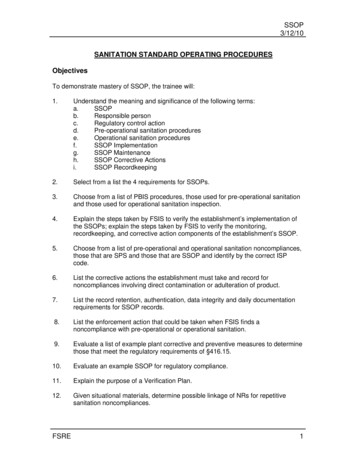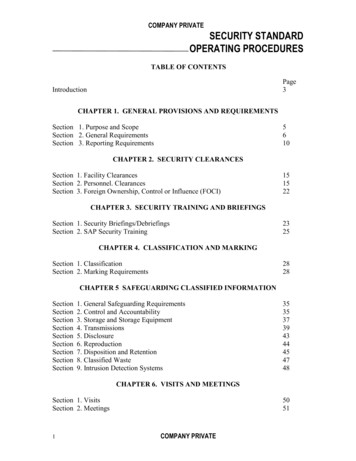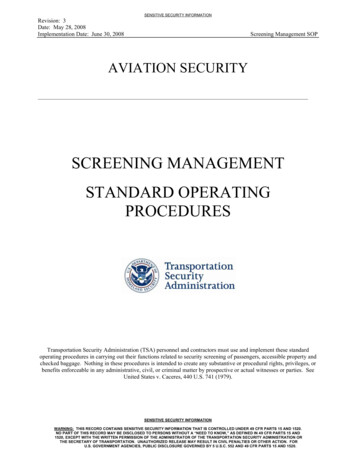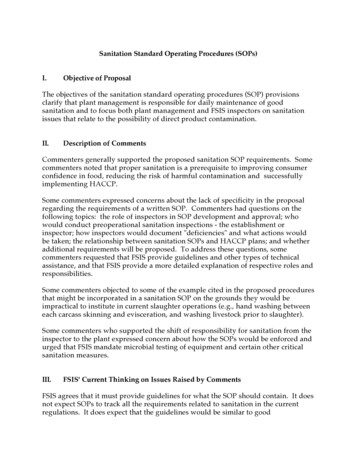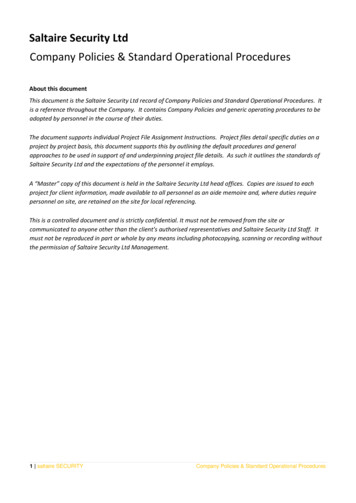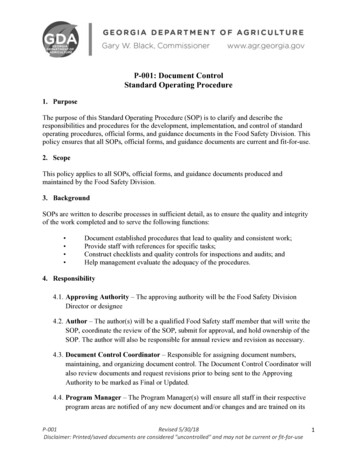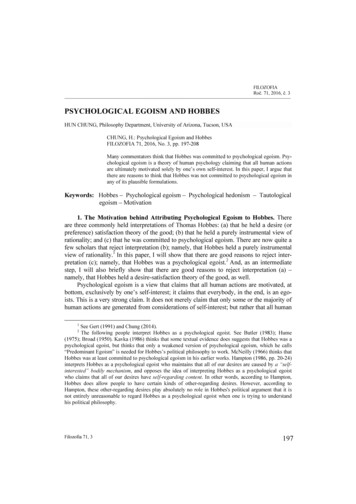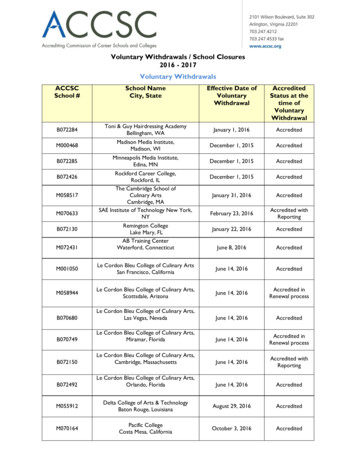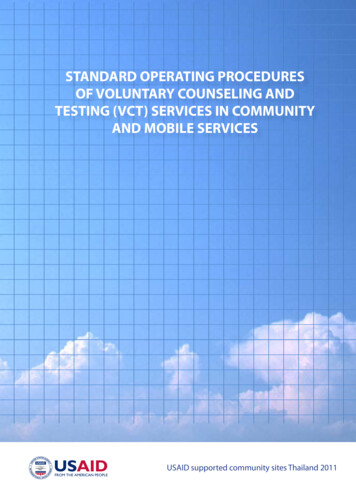
Transcription
STANDARD OPERATING PROCEDURESOF VOLUNTARY COUNSELING ANDTESTING (VCT) SERVICES IN COMMUNITYAND MOBILE SERVICESUSAID supported community sites Thailand 2011
In July 2011, FHI became FHI 360.FHI 360 is a nonprofit human development organization dedicated to improving lives in lasting ways byadvancing integrated, locally driven solutions. Our staff includes experts in health, education, nutrition,environment, economic development, civil society, gender, youth, research and technology – creating aunique mix of capabilities to address today’s interrelated development challenges. FHI 360 serves morethan 60 countries, all 50 U.S. states and all U.S. territories.Visit us at www.fhi360.org.
STANDARD OPERATING PROCEDURESOF VOLUNTARY COUNSELING ANDTESTING (VCT) SERVICES IN COMMUNITYAND MOBILE SERVICESUSAID supported community sites Thailand 2011USAID, 2011Any part of this document may be freely reproduced with the appropriateacknowledgement.iii
AcknowledgmentsThis Standard Operating Procedure (SOP) manual was developed by Dr Kathleen CaseyRegional Adviser, Testing, Counseling and Behavioral Interventions; Ms. Aramsri Sriburi, SeniorLaboratory Specialist and Mr. Greg Carl, Consultant with contribution from Mr. Siroat Jittjang,Senior Technical Officer, Men Sexual Health and Ms. Lalida Ketgudee, Program officer and Mrs.Aranya Ngawong, translator.iv
Table of ContentsIntroduction to C-M VCT 1SOP 301:Group Pre-test Information 5SOP 302:Individual Pre-HIV Test Counseling 6SOP 303:Individual Post Test Counseling8SOP 304:Counseling on the First Follow-Up Visit12SOP 305:Partner Disclosure Counseling 13SOP 306:Counseling Couples in VCT 15SOP 307:Counseling and Testing after Sexual Assault16SOP 308:Laboratory Safety and Universal Precautions18SOP 309:Venous Blood Collection Procedure21SOP 310:Management of Post-Exposure Prophylaxis (PEP)22SOP 311:HIV Rapid Test Procedures 24SOP 312:Laboratory Quality Assurance, Quality Control andExternal Quality Assessment 30SOP 313:Waste Disposal 32SOP 314:Space and Supplies for VCT CentersSOP 315:Staffing for VCT Services 36SOP 316:Code of Ethics 37SOP 317:Recording and Reporting 40SOP 318:Retention and Disposal of Medical and Study Records41SOP 319:Protocol for Managing Requests to Conduct Research42SOP 320:Subpoenas, Summons and Arrest on Premises4334Annex 1:Service Related Forms 46Annex 2:Checklist for VCT Service Evaluation53Annex 3:Commitment to Confidentiality and Quality Care54v
Introduction to C-M VCTCommunity based and mobile VCT services aim to increase access to testing and counselingamong men who have sex with men and transgender (MSM & Transgender) in Thailand Theseservice delivery points are referred to as Community VCT and Mobile (C-M VCT) Centers. Theservices provided through the C-M VCT Centers include: Clinical management of sexually transmitted infections Voluntary counseling and testing (VCT) services Essential package of care (EPC) to people living with HIV/AIDS (PLHA) Referral for other servicesRationale of the community and mobile servicesVoluntary counseling and testing (VCT) allows individuals to learn their HIV status. Afterlearning of their status, activities for positive life changes can be initiated involving physical,emotional and social health. Making good decisions and providing support early can greatlyenhance the future life of PLHA. Post-VCT services should also reach clients who have recentlylearned that they are positive.C-M VCT Site Commitment and AccountabilityTo ensure C-M VCT site commitment and accountability, it is important that:1. C-M VCT staff holds monthly meetings to review site functioning and take necessarymeasures whenever indicated.2. Quality assurance team from the Technical Unit of FHI Thailand (may include anFHI external consultant also) will conduct site assessments on at least three visits.New sites or sites requiring additional support will be monitored as needed. The FHILaboratory Specialist will coordinate with the quality assurance team regularly andbe responsible for overall quality assurance.3. The C-M VCT staff will have primary responsibility for all dealings with C-M VCTclients, including test quality control, counseling and adherence to confidentialityrules. Responsibility includes handling client complaints, ensuring the maintenanceand security of client files, and ensuring that procedures or protocols are adhered to.Standards for General Service ProvisionIn order to maintain high quality of services, the C-M VCT site management will make surethat:1. A client is attended to immediately. No client is made to wait unattended for a longtime.2. Approximate time for all procedures is written in Thai and displayed at the placewhere everybody can see.3. Each site has a client flow management plan. A system of giving fixed appointmentfor coming clinic days should be in place and clients should be entertained on thedate and time of their appointment.4. Procedures and protocols developed for the C-M VCT centers are strictly followed.5. HIV/STI test results are shown to the client in person only and are not provided overthe phone. Results should only be provided to the client and someone with client’swritten consent only after they sign a “Release of Confidential Information” form.1
Introduction to C-M VCT6. Copy of the test results required for medical or referral purposes are provided onlyafter signing “Release of Confidential Information” form by the client and providedalong with a copy of the signed “Release of Confidential Information” form.7. Condoms and demonstration models (dildos) for condom demonstrations areavailable on-site at all times. Sufficient models for condom demonstrations andgroup practice should be available.8. Confidentiality protocols are strictly followed. All C-M VCT staff are required to signan “Oath of Confidentiality” and the appropriate Code of Ethics standard operatingprocedure (SOP) should be read, signed and followed. These are to be filed with theIA Manager.9. Written consent is obtained from the guardian if a minor is brought for testing.10. Ensure that every client is given a VCT card with client file and/or code number.11. Counseling must be conducted in private, where the conversation between clientsand counselors cannot be overheard or seen by othersStandardize Service Provisions at C-M VCT CentersHIV Counseling1. Provide standardized counseling procedures.2. Conduct standardized counselor training for all C-M VCT counselors, includingongoing in-service training and guest lectures/ talks for counselors.3. Conduct regular supervision sessions/ stress management workshops for VCTcounselors to prevent counselor burnout.4. Introduce a counseling quality assurance system to monitor performance ofcounselors on a regular basis.HIV Counseling: A Brief Overview1. Counseling is communication.Counseling is communication, both verbal and nonverbal, made in response to andin the presence of feelings. It is the work of supporting someone in making decisionswhen their willingness or ability to act is affected by their feelings. Effective counselingcan help a client to explore, express, understand, and accept feelings so that s/he canmake decisions.2. Counseling is not education.Counseling is different from education, although education can be a componentof counseling. Good counseling does not equal good information giving. Goodcounseling is “client-centered”, it is tailored to the behaviors, circumstances, andspecial needs of the person being served.3. Counseling is not solving the problem or giving advice.Counseling is not solving the client’s problem for him/her or giving advice, it isfacilitating problem solving. In the counseling process, the counselor avoids takingon the client’s problem or telling the client how to solve the problem or what decisionor action to take. Instead, the counselor brings a set of skills to the interaction that canenable the client to reach a better understanding of the problem, deal with her/hisrelated feelings and concerns, and assume responsibility for evaluating alternativesand making choices.4. HIV prevention counseling is different than ongoing counseling.The HIV prevention counseling intervention is focused on an immediate presentingproblem related to HIV. Referrals are made for problems falling outside the scope of theclinic services or the expertise of the counselor.2Standard Operating Procedure (SOP) of Voluntary Counseling and Testing (VCT) Services in Community and Mobile Services
5. HIV prevention counseling is client-centered.HIV prevention counseling is a client-centered exchange designed to supportindividuals in making behavior changes that will reduce their risk of acquiring ortransmitting HIV.Introduction to C-M VCTClient centered counseling: is tailored to the behavior, circumstances and special needs of a person; focuses on personal risk assessment and development of a personalized actionplan; takes into account client’s emotional reactions, interpersonal situations, specificrisk behaviors and client’s readiness to change his/her behavior; content depends on the client’s level of knowledge and his/her specific concernsabout HIV/AIDS; develops individualized risk-reduction plan for each client; identifies the general problem; and makes a referral based upon the client’s needs.6. Counseling in C-M VCT Center is provided by a qualified and trained counselor only.Counseling must be conducted in private where the conversation between counselorand the client cannot be overheard by others.7. Each C-M VCT Center: Offers testing to all clients on an opt-out basis. In an opt-out approach, an HIV testis routinely recommended and provided to each client, and the client is informedof his or her right to refuse (to opt-out) the test. Ensures that the Counselor: follows the counseling protocols as shown in this chapter, and maintainsmedical records which are included in the appendix; meets with each client for a minimum of 20-30 minutes during a pre-testcounseling session, and 20-60 minutes during a post-test counseling. Pre-testcounseling and post-test counseling sessions are separated by testing time togenerate test results. Rapid testing may need up to 60 minutes; conducts couple/group information sessions as the need arises; abides by all ethical standards in counseling; becomes empathic and very professional while dealing with clients; and appears presentable and professional.HIV Testing1. The USAID supported C-M VCT Centers will follow the same-day testing protocolalgorithm that has been recommended by the MOPH Thailand2. The CDC TUC will procure the rapid HIV, test kits for use by the C-M VCT centers.3. C-M VCT staff performs the test according to this SOP. CDC TUC will arrange trainingfor the staff on testing procedures.4. All HIV positive patients will be referred to HIV treatment and care services.5. A system for both internal and external quality assurance for the tests and the testingprocedures will be in place. The project FHI Laboratory Specialist will be responsibleto collect information from the reference laboratory and provide feedback to theimplementing agencies (IAs).Note: This SOP manual covers the HIV counseling and testing component of C-M VCT. It isrecommended to revise this manual every year to include new developments in the field.3
SOP 301: Group Pre-test InformationIt is recognized that in many settings the demand for VCT is high and resources are limited.Often clients are kept waiting in busy waiting rooms for long periods of time where as this timecould be utilized to reduce the amount of individual counseling time required. The informationcomponents of pre-test counseling could be provided in a group setting whilst issues specificto the individual could be discussed on an individual level.The Counselor will:a. Provide the following in group information sessions: Information on confidentiality and privacy of the clients; Basic information about HIV; Basic information about HIV transmission and HIV risk reduction; Demonstration and discussion about condom use; The benefits and potential issues related to testing; The testing procedures and how results are provided; and General information about reproductive healthb. A trained peer educator/volunteer can provide basic general information in settings withlimited counselor availability and this individual must use the provided Group Pre-testinformation session flip chart.c. Always do the following: Always obtain informed consent for group pre-test; Ensure adequate privacy; Restrict group size to not more than 10 individuals; Only discuss the issues suggested above; and Do not provide results of the HIV testing in the group (NEVER).4Standard Operating Procedure (SOP) of Voluntary Counseling and Testing (VCT) Services in Community and Mobile Services
SOP 302: Individual Pre-HIV Test CounselingIt is the part of VCT counseling, which is done to prepare the client for testing. It is called pretest counseling as it is done before testing for HIV.The Counselor will:1. Cross-check code numbers on ALL forms against the client’s code.2. Introduce and orient the client Name, designation and rolei.e. “My name is . I am a counselor at this centre. My role is to discuss issuespertaining to HIV and AIDS and any other concerns that you may have.” Confidentiality (including discussion of sensitive issues) and anonymity.i.e. “Whatever we discuss will remain within this centre and is confidential. Any information that we get from you in relationship to HIV is kept in your file, with only your codenumber on the outside. These files will be kept separately and used only in the provision ofmedical care and counseling for your benefit.” VCT process outline – sessions, duration, testing procedures.i.e. “Our services are for people who come to this centre voluntarily. We will talk for 20 to 30minutes. If you decide to be tested, you will need to wait approximately 20 to 60 minutesfor the results. You will need a further 15 to 60 minutes to discuss the results after that.” Record taking by counselori.e. “At the end of the session I will take down a few notes on our discussion for recordkeeping purposes.” Discuss measures you will take to keep confidentiality.3. Provide basic information about HIV and transmission discussing briefly the key methodsof infection and also briefly how you cannot contract HIV.4. Conduct clinical risk assessment. Combine risk education and assessment of risk. Give thefollowing explanation for discussing sensitive issues: “I need to discuss some things todaythat perhaps normally we wouldn’t discuss with others. I need to discuss these things inorder to be able to: Give you realistic feedback about your risk of being infected – you may be worryingunnecessarily. Ensure you know how to keep yourself and partners safe in the future – different practices have different risks. See if you have other potential health problems that this test will not identify – maybewe will need to consider other types of tests. Make appropriate treatment and care suggestions. If you test HIV positive it would beimportant for us to know when you most likely contracted HIV or any other infectionsas this may determine the type of care offered.”“As you can see these are some good reasons for us to talk openly about these things eventhough it may not be comfortable”.5
SOP 302: Individual Pre-HIV Test CounselingThen proceed with clinical risk assessment. Provide information first followed by assessmentof the client’s individual risk, when the risk occurred and whether this date falls within thethree-month window period. Provide feedback to clients on their risk. Avoid saying they arevery high or low risk. Talk to them in terms of having significant risks or appearing to havelimited risks. Remind clients that the only way they can know if they are infected is by havingan HIV test.5. Discuss prevention related issues - condom use, including condom demonstration andsafe injecting information. Exploration and problem solving of constraints to risk reductionshould be offered. Such exploration may include: Risk reduction attempts [previous] Details of successful attempts Details of failed attempts/obstaclesFor e.g. “What has been the most difficult part of reducing your HIV risk?” Assess condom use skills and condom demonstration Re-visit risk triggers for high risk behavior Engage in structured problem solving with the client to resolve difficulties inengaging in transmission risk reduction strategies, and develop a personal riskreduction plan for the client.6. Discuss testing: provide basic information about the test and how results are provided.Some points to discuss here include: Explain HIV testing procedure and possible test results Discuss meaning of positive, negative and indeterminate results Discuss advantages and disadvantages of having an HIV test Advantages include being able to look after your health by seeking treatment Discuss implications of results to self, partner and family Explain about the window periodWhen HIV infects a person’s body, their body realizes HIV is a virus that should not be inthe body. The immune system in the body will begin to develop antibodies to try to kill theHIV and protect the person. The test used to check for HIV looks for these antibodies in theblood, and is called an antibody test.It can take up to 12 weeks after infection with HIV for these antibodies to develop. Thismeans that an HIV test can not guarantee a person’s HIV status as negative if they havehad any risk for HIV in the 12 weeks immediately before the test. This time period of 12weeks before the test is called the “window period”.7. Obtain informed consent to undergo HIV testing and note on counseling record form.6Standard Operating Procedure (SOP) of Voluntary Counseling and Testing (VCT) Services in Community and Mobile Services
SOP 303: Individual Post Test CounselingPost test counseling is carried out to prepare the client to receive the results of the test. No testresult should be given without appropriate counseling. At this stage clients are in a state ofanxiety and stress, and proper care should be taken.The Counselor will:1. Understand Resultsa. Negative Test Result – A negative test result is given if the first screening test or the tiebreaker test in the serial algorithm shows non-reactive result. A negative test meansthat the person is either (1) not infected with HIV, or (2) so recently infected that thetest could not detect the HIV antibodies (window period).b. Positive Test Result- A positive test result is given if both first screening and secondconfirmatory tests or the tie-breaker test show reactive result in the serial algorithm. Apositive test means that the person is infected with HIV, that the HIV antibodies havebeen detected and that the person can transmit HIV to others.c. Indeterminate/Inconclusive Test Results- In the national serial testing algorithm thereis no provision for indeterminate test result. All reactive with the first screening testare tested with the second confirmatory test and if both give different result, thenthe third tie-breaker test is used. The result of the tie-breaker test is taken as final. Anindeterminate/inconclusive test result may either represent: A biologic false positive test result, or A truly positive test from a recent infection in which antibodies have not yet fullydeveloped.Clients must take the same risk reduction precautions as persons testing HIV positiveuntil the indeterminate finding is resolved.Need for repeat test:A repeat test is recommended 6 weeks for pregnant women, and 12 weeks for othersafter the date of the inconclusive test result (or sooner if desired by the client; howeverthe result may not be accurate before 6 weeks).2. Provide Results:Key Principlesa. The result giving session addresses following main areas:i. Giving test results, which includes dealing with emotional reactions and re-visitingrisk reduction plansii. Repeat counselling sessionsb. Show the result in person on an individual basis: Not on the phone Not in the mail Not to other people – staff, friends or family NOT in groups ( even if negative)7
c. Check the details of client medical record with test results – make sure the results are inthe correct medical record.d. Check the details of client medical record with the client – make sure you are giving theresults to the correct client.SOP 303: Individual Post Test CounselingProviding HIV Negative Test Results1. After seating the client and confirming that they are ready for their results simplyexplain the result is HIV negative.2. Explain that the test has shown that the client is not infected however explain that if arisk occurred within the last three month period before the test was taken it will meanthat there is still a chance that they may be infected and that this has not yet shown upin the test result that they have received today.3. Check for any window period exposure that the client may not have disclosed at thetime of pre-test counselling. If the client has not received a same day test result alsodiscuss if their have been risks since the test was taken.4. Advise the client with “window period” exposure of the need to practise safer sexthroughout the life until a further test has been conducted. Advise them of theimportance of this, emphasizing that people may be highly infectious when they firstcome into contact with HIV, even though the first test may have indicated that they arenot infected.5. Inform the client who has had “window period” exposure that they require a further retest and based on the last risk behaviour advise them when to present for that re-test(give a date for re-testing).6. Review the common means of how HIV infection is tranmitted and how transmissioncan be prevented. Review the clients decisions about a personal risk reduction plan.Providing HIV Positive Test ResultsAfter seating the client and confirming that they are ready for their results simplyexplain the result is HIV positive. The results should be given promptly and then allowtime for the news to sink in. The counselor should help the client to regain a sense ofcontrol by helping them to: Freely express their anxiety and fears. Feel more secure by being warm and maintaining a calm presence. Explore exactly what it is that seems overwhelming. Break down the problems into manageable aspects and set priorities. Help client to develop an action plan for coping.The steps to follow are:1. Be aware of non-verbal communications when calling client to the counseling roomfrom the waiting room.2. Check client details.3. Be direct e.g. “I need to tell you that your result has come back positive and that meansthe HIV virus has been detected in your blood, which means you are infected with the virus”4. Provide some silence and time for the client to absorb the news.5. Make a gentle enquiry “I’m wondering what you’re thinking or feeling right now ”6. Encourage ventilation of emotion (normalize).7. Check the client’s ability to cope emotionally, assess for possible self-harm (suicide) orof the client threatening harm to others. Refer to the “Detailed suicide/harm to othersschedule” in the appendix.8Standard Operating Procedure (SOP) of Voluntary Counseling and Testing (VCT) Services in Community and Mobile Services
SOP 303: Individual Post Test Counseling8. Provide brief information about:a. Follow-up and support availableb. Provide contact number of the C-M VCT center, hotline telephone number ifavailable in the areac. Incase of emergency go to the nearest hospitald. Provide a back-up to verbal information about diagnosis with written information.E.g. IEC materials.9. Assist client with concrete planninga. Planning to reduce HIV transmission to othersb. Address issues related to disclosure (who, what, when and why). See violencequestions in the box that follows.c. Leaving the clinic e.g. consider how will a distressed client get home?d. Planning for the next 48 hours. This should include a follow up counseling visit.10. Offer all clients testing positive an appointment for Essential Package of Care services.a. If these are available the same day, this is best.b. Some clients may not be ready and may need some time before this step, but anappointment date should always be given.c. It is extremely important to emphasize that there are things that the client can doto live a longer, healthier and normal life. Getting regular check-ups by a providerwith knowledge in HIV is one of them. There are preventative medicines thatcan extend life and in most parts of the country ART is available, which can treat,although not cure, HIV.11. Remember to ask if the client has any further questions.12. Ask clients to write future questions down that arise between visits.13. Provide referrals as required ( Use the referral form)Possible emotional responses to positive resultsCrying - if the client breaks down and starts crying, it is important to let them cry. Give themspace to ventilate these feelings. Offering them tissues is a way of telling them that it is okayto cry. Comment on the process, ‘This must be difficult for you, would you like to talk about it?Would you like to tell me what is making you cry?”Anger – the client might start swearing or exhibit outbursts of anger. Do not panic, stay calmand give the client space to express their feelings. Acknowledge that their feelings are normaland let them talk about what it is making them angry.No response - this could be due to shock, denial or helplessness. Check that the clientunderstands the result. Be on the alert for suicidal thoughts.Denial – this could be verbal or non-verbal. Counseling should acknowledge client’s difficultyin accepting the information. Let them talk about their feelings.The most important thing to remember in dealing with feelings is that it is very important to allowfree expression of feelings. Listen to the concerns and fears of the client.9
Coping strategiesEncourage the client to ask questions!SOP 303: Individual Post Test CounselingBe prepared to answer any questions honestly and with as much detail as is required. Don’tbe embarrassed to say you don’t know some of the answers.At some point an HIV positive client will need information on the following aspects:10Standard Operating Procedure (SOP) of Voluntary Counseling and Testing (VCT) Services in Community and Mobile Services Information on treatment and careHealth, rest, exercise, diet (lifestyle)Safe sexInfection control in the home and other social gatheringsYou will need to carefully judge how much information to give.Offer follow-up counseling sessions. In these sessions, the counselor is focusing on how theclient is coping with the positive status (preferably within 48 hour); or how they are managingto maintain the negative status. Infant feeding options are also discussed. Follow-up sessionsare supportive sessions where client’s concerns are dealt with.
SOP 304: Counselling on the First Follow-Up VisitThe Counselor will:1. Answer questions2. Assess impact of the diagnosis relationships occupational sexual health assess client comfort with communicating with clinical care providers partner disclosure issues including assessment for potential for violence relatedto disclosure (see appendix) other social issues sleep diet3. Engage the client in collaborative problem solving.4. Conduct a suicide/harm to others risk assessment.5. Further assist client in resolving issues and difficulties with disclosure of status tosexual partners or members of family or support network.6. Assist with referral for assistance for services that your center cannot provide.7. Workplace – client may find it hard to go to work when newly diagnosed. Assist themin making a plan around this issue.8. Follow-up on success and difficulties with the client’s personal risk reduction plan.9. Ask about initial visit for Essential Package of Care Services. If they have not yet seenthe doctor for this, assist in scheduling an appointment. If they have had the firstvisit, ask about outcome and further follow-up plans.10. Assist client in making decisions regarding treatment and gaining a referral.11. Review the client’s personal coping strategies and support needs. Refer for ongoingcounseling where needed.12. Refer using referral protocol described herein and use the consent form for referral.How many times after VCT should we see VCT clients ?Number of SessionsClients attending VCT are expected to attendat least one pre-test counseling session,receive their test results and attend one ortwo post-test counseling sessions. Someclients will require additionalcounseling sessions. Although clients that have been seenat the VCT sites are eligible to return foras many sessions as needed, counselorsshould be aware that these services are notintended to provide ongoing counseling orpsychotherapy. However, no client seekingtreatment will be refused. 11
SOP 305: Partner Disclosure CounselingThe Counselor will:Offer all clients at risk or diagnosed with HIV support in disclosure to partners. The followingsupport options should be routinely offered to all clients.Why do we need to encourage disclosure?1. Support broader access to treatment and care2. Major transmission risk reduction strategy for HIV and STI Primary transmission Re-infection The transmissibility of treatment resistance3. We need to explain to clients that we encourage partner disclosure for the followingreasons: People can have STI/HIV for a long time without significant symptoms and notknow and therefore pass to others (partners, children, blood donation). The person who is in the window period (has a recent high risk) for HIV, HBV or
Counseling is different from education, although education can be a component of counseling. Good counseling does not equal good information giving. Good counseling is "client-centered", it is tailored to the behaviors, circumstances, and special needs of the person being served. 3. Counseling is not solving the problem or giving advice.

